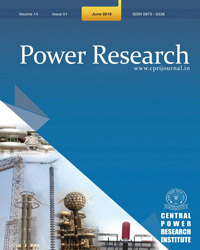A Brief Review of Super-excitation Schemes in Short-circuit Generators
Subscribe/Renew Journal
Most short circuit generators have static excitation systems to supply field current to the rotor circuit. All synchronous alternators suffer a reduction in the terminal voltage due to high armature reaction which is a result of the extremely high magnitude short-circuit currents. The reduction in terminal voltage will lead to a corresponding reduction in the stator current magnitude. The short-circuit generators are expected to maintain a constant magnitude of current for specified duration to complete the tests as per corresponding standards. Hence the short-circuit generators invariably make use of super-excitation to maintain the required magnitude of short-circuit currents for specified duration. During circuit breaker testing, it is required to maintain the recovery voltage at pre-fault levels. This requires significant over excitation of the machine. This paper presents a brief review of the methodology and algorithm of super-excitation schemesadopted in short circuit testing along with actual data recorded at the High Power Laboratory at CPRI, Bangalore.
Keywords
Short-circuit generators, transient behavior, super-excitation
User
Subscription
Login to verify subscription
Font Size
Information

Abstract Views: 440

PDF Views: 0



